Content
- 1 Features of lilac
- 2 Planting lilacs in the garden
- 3 Caring for lilacs in the garden
- 4 Reproduction of lilac
- 5 Lilac after flowering
- 6 Types and varieties of lilacs with photos and names
- 7 The most popular types of lilacs
- 8 Lilac: planting and care in the open field
- 9 How to properly prune lilacs
- 10 Reproduction of lilac
- 11 How to keep cut lilac fresh: tips
- 12 Plant diseases and pests
Lilac is a flowering shrub that is used for group and single plantings in city parks and in personal plots. Lilacs endure pruning and shaping, so hedges can be made from it.
Planting common lilac
The optimal planting time depends on the form in which the seedling went on sale. The best time to plant open-root seedlings is early fall. Planting lilacs in the fall should be completed by the end of September.
Lilac leaves retain their green color until frost, therefore, on a seedling intended for autumn planting, they should be green. If a lilac seedling without leaves is a bad sign, which means that the planting dates have passed. It must be placed in a ditch until spring, as is done with fruit tree seedlings.
The timing of planting lilacs in the spring is compressed. It is necessary to have time to get the seedling out of the trench and plant it in a permanent place before the buds bloom, so it is better to prepare the hole in the fall - then you will not have to gouge the frozen soil with a shovel. Planting lilacs in summer is possible if you buy a seedling in a container.
Lilacs take root if no mistakes are made during planting:
- Failure to meet deadlines.
- Planting in acidic, structureless clay soil.
- Landing in deep shade.
- Landing in a swampy or temporarily flooded area in the lowlands.
Lilac loves light, but it will not die in partial shade, but will not bloom as luxuriantly as in the sun. As for the quality of the soil, this plant grows freely even on poor, uncultivated land. But the plant feels better on fertile loose soil with a reaction close to neutral.
Lilac does not tolerate flooding and soils with a soil solution reaction below 5.5, on which the leaves turn yellow and crumble. For the planting of lilacs to succeed, the soil must be breathable.
How to plant lilacs:
- Digging a hole. The less cultivated the soil, the larger the hole should be. The free space in the pit is filled with fertile soil mixed with a small amount of compost or peat - up to 1/4 of the soil volume. In old gardens, you can dig small holes for lilacs - such that only the roots of the seedling fit in them.
- The grafted lilacs are planted so that the grafting site is at the soil level. The grafting should not be in the soil, so that the plant does not pass on to its roots. An exception will be seedlings grafted onto Hungarian lilacs or privet, which are planted with the grafting deepening to make them more durable.
- Own-rooted lilacs are buried when planting so that additional roots are formed.
- The roots are covered with fertile soil and trampled underfoot, forming a near-stem hole. First you need to make sure that the root collar is at the right level.
- The well is poured abundantly with water.
Planting Hungarian lilacs, as well as Persian and Amur, is carried out according to the same rules as in the case of common lilacs.
How to care for lilacs
Caring for lilacs is no different from caring for most winter-hardy ornamental shrubs. Lilac tolerates cold weather, so it does not have to be insulated for the winter. Only in young grafted plants in the year of planting can the trunks be mulched with a thick layer of fallen leaves.
After planting, the plant is watered abundantly until it starts to grow. Watering lilacs is needed only when necessary - in the heat. Autumn water-charging irrigation for lilacs is not carried out.
In the early years, until the lilac blooms, fertilizers are not applied under it. Plants have enough organic matter added to the planting pits. Young bushes need loosening of the soil, weeding and watering.
The lilac bush begins to bloom in the third year. Then you can start the annual feeding. Mineral fertilizers will make the brushes larger, brighter and more aromatic, and increase their number.
In the spring, before flowering, you need to have time to loosen the soil in the near-trunk circle at least once and feed the plant with any complex mineral fertilizer, soluble in water. The roots of the lilac are superficial, so you need to loosen the soil carefully and shallowly.
Lilac care after flowering
Loosening and watering is stopped by the beginning of August, so as not to stimulate the growth of shoots. The wood must have time to ripen by winter, and for this it needs to stop growing in time.
Caution should be exercised only with nitrogen fertilizers, with an excess of which the lilac begins to fatten, that is, instead of flowering, it will begin to throw out new shoots and leaves. On the other hand, in order to bloom annually, the bush must give normal growth, which is impossible without nitrogen. Here you have to look for a "golden mean" - for example, very moderately feeding the plant once a season with urea or mullein, and do this in early spring, when the buds are just beginning to wake up.
Unlike nitrogenous minerals, phosphorus and potassium minerals will do nothing but benefit. Phosphorus is introduced in the fall, at the beginning of October, in the amount of 40 grams. for young and 60 gr. on an adult bush. This element affects the size and quality of flowers.
Potassium makes the plant winter hardy. After potash fertilization, flower buds tolerate frost well, do not freeze and the bush blooms profusely in spring. Potassium is added together with phosphorus at the rate of 3 tbsp. on a large adult bush.
Lilac loves feeding with wood ash, since this substance, unlike mineral fertilizers, does not acidify, but alkalizes the soil. Ashes are poured with cold water - 1 glass per 10 liters, insisted for 2 days and poured onto each bush, 2 buckets of such an infusion. But first you need to water the plants with clean water so as not to burn the roots.
Ash bushes are fed twice a season: immediately after flowering, when new flower buds are laid, and in October. If ash is applied, then mineral fertilizers do not need to be added in the fall.
Lilac pruning
Lilac is grown in a bush with several skeletal branches extending from the ground, but if you wish, you can form a tree from it on a low trunk. In both cases, the bush will need enough space.
If the task is to get a harmoniously developed bush that will decorate the site with abundant flowering and a beautiful shape, then, when choosing a place for planting a seedling, make sure that neighboring plants, fences and buildings are no closer than 1.2-2 m.
Growing lilacs
For lilacs to receive proper care, pruning must be systematic. The bush will have an attractive shape and will be able to bloom annually.
Bush
Pruning begins when the plant begins to form skeletal branches. This happens in the third year.
Skeletal branches will later become the basis of the bush. Of course, the bush itself will form them. By intervening in this process in time, you can better influence the future shape and size of the bush.
In the third year in early spring, while the buds are still sleeping, and the branches are not hidden by foliage and are clearly visible, up to 10 evenly spaced branches are found on the plant, which must be left. The remaining branches are cut off.
In the future, they are limited to sanitary pruning, cutting out branches in early spring that grow inside the crown, dried up over the winter and damaged by pests. If necessary, sanitary pruning can be carried out at any time during the growing season. Wild growth is removed from grafted lilacs in spring.
When the lilac blooms, more than half of the flowering shoots can be cut off from it without harming the plant and used to create bouquets. If they are not cut, then the next year fewer shoots will form and flowering will be weak. It is better to immediately remove faded brushes from the branches with pruning shears so that they do not spoil the appearance of the bush.
Lilac flowers are best cut early in the morning, before the dew dries. In order for the flowers to stand in the water longer, the ends of the shoots should be split with a hammer or knife.
A bush over 10 years old can be rejuvenated by removing one skeletal branch per year. New skeletal branches are formed from dormant buds, which bloom on the trunk next to the marks from the sawn branches.
In the form of a tree
- Immediately after planting, remove all side branches, if any.
- When the seedling begins to grow, all side branches are removed from it, while they are green and weak, leaving the stem growing upward.
- When the stem reaches the desired height - in the second year, pinch its top. After that, it will stop growing up and become a stem.
- After pinching the top, dormant buds will wake up in the upper part of the trunk, from which several shoots will begin to grow upward. Of these, you can leave as many skeletal branches as the future tree is supposed to have.
Experience shows that the optimal stem height for lilacs is 80-100 cm, and the upper 30 cm of the stem should be occupied by side branches. With a lower stem - 50 cm, the tree does not look like a standard tree, and with a high stem it is difficult to carry out sanitary pruning and cut off flower brushes.
Creating a lilac hedge
Amur lilacs are suitable for use as a hedge, because after pruning, the branches do not stretch up very much, like in other species. Low-growing Mayer's lilac is also suitable.
Saplings for the hedge, which is supposed to be cut annually at a height below human height, are planted a meter apart. Such a hedge will not bloom, but it looks neat. For a flowering hedge, lilac bushes are planted 1.5 meters from each other.
In the second year, young, not yet lignified branches of neighboring bushes are intertwined like a fishing net, securing them in this position with a rope or soft wire. When such a hedge grows, neither a man nor a large animal can cross it.
Lilac grows quickly, and with regular watering, already in the third year, forms a dense green "fence", which you can start cutting. High hedges are pruned after flowering, low hedges at any time.
Reproduction of lilac
Lilacs can be propagated by seeds and vegetatively. With the seed method, parental traits are not preserved, therefore the only way to propagate planting material is vegetative, and the seed method is used only to obtain new varieties.
Lilac vegetative propagation methods:
- vaccination;
- layering;
- green cuttings.
Reproduction by grafting allows you to quickly get a large amount of planting material of the same height. The method is available only to gardeners with skills.
Lilacs are grafted by cutting or budding. For the stock take Hungarian lilac or privet.
"Hungarian" and privet are not very successful rootstocks for common lilac, since in this case two different species merge into one whole. The resulting plant will not be durable. The life span depends on a mass of factors and is 2-20 years.
"Hungarian" and privet are often used in nurseries as a rootstock. The fact is that the seedlings grafted on them come to the middle lane from the southern regions. Privet is cut and transported, but in reality it is an unreliable stock, valuable only for its cheapness.
It is more convenient for the gardener to root-own seedlings obtained from layering in amateur conditions or cuttings in industrial conditions. Own-rooted plants are durable and do not produce wild growth. Not all varieties of lilacs are propagated by layering in amateur conditions, this is especially true for modern - fashionable and sophisticated varieties.
Propagation by cuttings
Cuttings are harvested during flowering or immediately after. For cuttings, branches from the middle part of the crown are suitable, except for tops. Cuttings are cut from the branches, each should have 2 internodes.
Leaves are removed from the lower node. The upper pair of leaf blades is cut in half.
The cuttings are dipped for several hours in a heteroauxin solution and planted in a greenhouse in a 1: 1 mixture of sand and peat, under plastic wrap or cut plastic bottles. The air under the film should be humid all the time, for which the cuttings are sprayed daily from a spray bottle, and the soil is watered. Roots on cuttings do not appear earlier than after 1.5 months.
After the roots grow back, the greenhouse is ventilated, starting from several hours a day. Then the shelter is removed, leaving the cuttings to harden in the open air and not forgetting to water and weed from the weeds. The cuttings are left to winter here, and the next year in the fall they are dug up and transplanted to a permanent place.
In early May, it is pleasant to sit in the garden under a flowering lilac bush, breathing in a fresh and recognizable aroma. Planting and caring for it is not difficult, but a beautiful plant is worth giving it a little time and work. It responds to any, the most modest care, responding with lush and long flowering.
Such a shrub as lilac is a representative of the olive family. According to information taken from various sources, this genus unites from 22 to 36 species. In nature, such species can be found in the mountainous regions of Eurasia. The genus lilac has a typical species - common lilac (Syringa vulgaris). In natural conditions, such a shrub can be found along the lower course of the Danube, on the Balkan Peninsula and in the South Carpathians. Lilac is cultivated as an ornamental plant, and it also strengthens and protects slopes that are exposed to erosion. In the second half of the 16th century, the Roman ambassador brought lilacs to European countries from Constantinople, since that time this plant has appeared in the gardens of Europe. The Turks called this shrub "lilak", and the inhabitants of Germany, Flanders and Austria gave it the name "lilac" or "Turkish viburnum".
At first, lilacs were not in great demand among European gardeners, because it did not bloom for long, and loose inflorescences with small flowers did not have a high decorative effect. But everything changed after the Frenchman V. Lemoine received several dozen varieties of this plant, which were distinguished by lush and long flowering, as well as beautiful dense inflorescences with the correct shape. He also managed to breed several varieties with double flowers of various colors. Emile Lemoine continued his father's activities, as did his son Henri. Thanks to the Lemoans, 214 varieties of lilacs were born. From the French breeders of lilacs, they paid attention to: Auguste Gouchaux, Charles Balte and Francois Marel. At the same time, Wilhelm Pfitzer and Ludwig Shpet worked on the development of new varieties of lilacs in Germany.In Holland, at the beginning of the 20th century, new varieties of this shrub were born, and Klaas Kessen, Dirk Evelens Maars, Jan van Tol and Hugo Koster worked on this, and the Polish breeder Karpov-Lipski also worked in this direction.
At the beginning of the 20th century, lilac became quite popular in North America, while its new varieties were born thanks to such breeders as John Dunbar, Gulda Klager, Theodore Havemeyer and other fairly well-known specialists from Canada and the United States. Also, new varieties of lilacs were bred on the territory of Belarus, Russia, Ukraine and Kazakhstan. Today, there are more than 2300 varieties of this plant, which differ in color, size and shape of flowers, flowering time, habit and size of the bushes. 2/3 of all varieties were bred using common lilac.
Features of lilac

Lilac is a deciduous, multi-stemmed shrub that varies in height from 2 to 8 meters. The diameter of the trunks is about 0.2 meters. The color of the bark is brown-gray or gray. Young trunks are covered with smooth bark, while old ones are fissured.
The foliage bloom relatively early, while it stays on the branches until the onset of frost. The length of opposite leaf plates is about 12 centimeters, as a rule, they are solid, but there are also pinnately-separated. In different species, the shape of the leaf can differ, for example, it can be heart-shaped, oval, ovoid or elongated, sharpening in the upper part. The color of the foliage is dark or pale green. The length of the terminal drooping panicle inflorescences is about 0.2 m, they include flowers that can be painted in lilac, blue, pink, white, purple or violet. The flowers have a short, bell-shaped, four-toothed calyx, 2 stamens and a corolla with a four-part flat limb and a long cylindrical tube. Many are interested in exactly when the lilac flowers bloom. It depends on several factors, namely: the species, weather and climatic conditions. Such a shrub can bloom from the last days of April to the first - June. During the flowering of lilacs, the garden is filled with a unique, delicate and very pleasant aroma. The fruit is a bivalve capsule with several winged seeds inside.
If you provide the plant with the most favorable conditions, then its life expectancy can be about 100 years. Lilac is very easy to care for, it is frost-hardy and is one of the most popular ornamental shrubs, along with hydrangea and chubushnik (garden jasmine).
Planting lilacs in the garden

What time to plant
The best time to plant lilacs in open soil is from mid-July to early September. It is not recommended to plant such a shrub in spring or autumn, as it does not take root well and almost does not grow for 1 year. For planting, choose a sunny place with moderately moist soil saturated with humus, and its acidity should be 5.0-7.0.
When buying seedlings, be sure to carefully examine their root system. You should stop your choice on a plant with a well-developed and branched root system. Before planting a seedling, all injured roots that have begun to dry out and damaged by the disease should be cut out from it, the remaining ones should be shortened to 0.3 m. Injured stems should be removed, and excessively long ones should be shortened.
Landing features
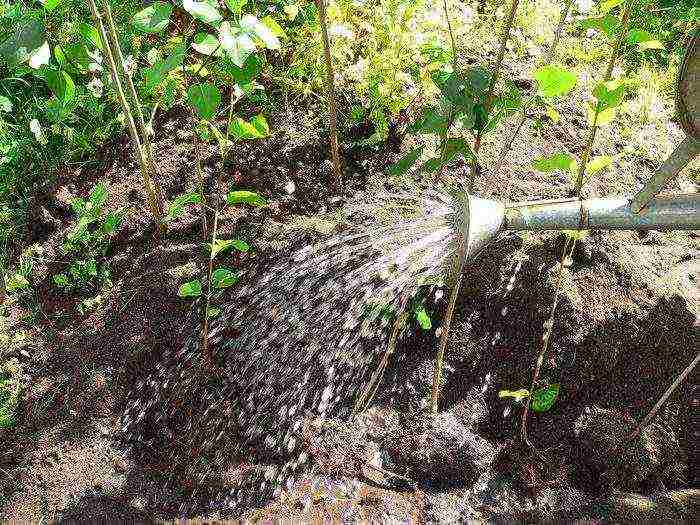
When planting several seedlings, do not forget to leave between them from 2 to 3 meters (depending on the type and variety) of an empty space. When preparing a pit for planting, it should be borne in mind that it must have sheer walls. If the soil fertility is high or medium, then the size of the pit will be 0.5x0.5x0.5 meters.If the soil is poor or sandy, then the hole needs to be made 2 times larger, because during planting the seedling it will be necessary to fill it with a nutritious soil mixture, which includes: humus or compost (from 15 to 20 kilograms), wood ash (from 200 up to 300 grams) and superphosphate (20 to 30 grams). Wood ash should be taken 2 times more if the soil on the site is acidic.
At the bottom of the pit, you need to make a good drainage layer, for this you can use crushed stone, expanded clay or broken brick. Then a nutrient mixture is poured into the pit in such a way that a mound is obtained. Further, the plant is installed in the center of the pit directly on the mound. After its root system is straightened, the pit must be completely filled with soil mixture. In planted lilacs, the root collar should rise by 30–40 mm above the surface of the site. The planted shrub must be well watered. When the liquid is completely absorbed into the soil, its surface will need to be covered with a layer of mulch (peat or humus), the thickness of which should be within 5-7 centimeters.
Caring for lilacs in the garden

It is very easy to grow lilacs in your garden, especially since caring for it will not take a lot of time from the gardener. This shrub can grow without your participation, but it will be very good if from the beginning to the middle of the summer period you provide it with systematic watering as the soil dries up, while 2.5-3 buckets of water should be poured under 1 bush at a time. During the season, you will need to loosen the surface of the trunk circle 3 or 4 times to a depth of 4 to 7 centimeters. Also, do not forget to remove weeds in a timely manner. In August and September, it is necessary to water such a plant only when there is a prolonged drought. After 5 or 6 years, the lilac will become a very effective bushy bush.
For the first 2 or 3 years, lilacs are fed with only a small amount of nitrogen. Starting from the second year, ammonium nitrate is applied under each shrub in an amount of 65 to 80 grams or urea from 50 to 60 grams. But experienced gardeners recommend feeding the lilacs with organic matter, for this you need to pour 10-30 liters of slurry under the bush (cow dung should be dissolved in water in a ratio of 5: 1). To begin with, make a not very deep groove around the bush, stepping back at least 50 cm from the trunks. You need to pour the nutrient mixture into it.
Once every 2 or 3 years, the plant is fed with phosphorus and potassium, for this, for 1 adult bush, you should take from 35 to 40 grams of double superphosphate and from 30 to 35 grams of potassium nitrate. The granules should be buried 6-8 centimeters in the near-stem circle, then the plant must be watered without fail. However, the lilac responds best of all to feeding with a complex fertilizer, consisting of 8 liters of water and 0.2 kilograms of wood ash.
Transfer

Gardeners with considerable experience strongly recommend replanting it after 1 or 2 years from the date of planting. The fact is that such a plant very quickly consumes all the nutrients available in the soil, even despite systematic feeding. In this regard, after 2 years, the soil will no longer be able to provide the lilac with the necessary energy for lush and incredible spectacular flowering, and rapid growth.
Three-year-old bushes are transplanted no earlier than August. It is necessary to transplant young plants immediately after flowering at the end of the spring period, otherwise they will not be able to root normally until the first frost. The pit for the transplant must be made in the same way as for the planting. Then you should inspect the plant and cut out injured, dried up or unnecessary stems and branches. The shrub is dug in along the projection of the crown perimeter and pulled out of the ground along with a lump of earth. Then it is placed on a dense fabric or oilcloth and moved to a new landing site.The size of the new hole should be such that not only a bush with a lump of earth would fit in it, but also a sufficiently large amount of fertile soil.
Pruning
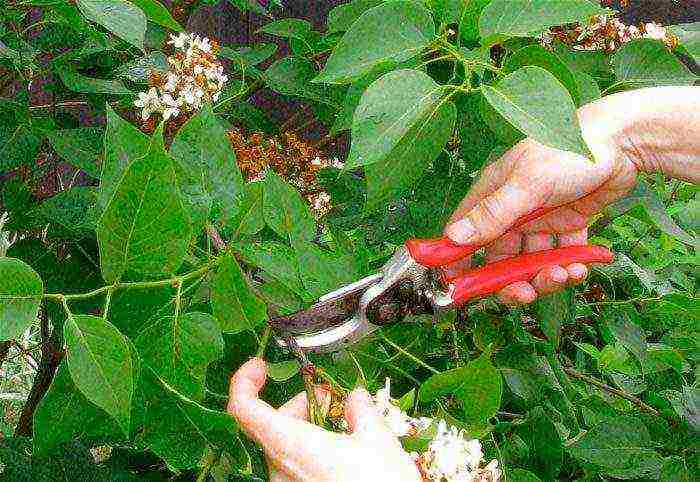
Before the bush turns 2 years old, it does not need to be cut off, since the skeletal branches at this time are still in the stage of formation. In the third year of a lilac's life, the formation of its crown should begin, this process will take from 2 to 3 years. Pruning is carried out in the spring, before sap flow begins and before the buds swell. To do this, select from 5 to 7 beautiful, equidistant branches, and the remaining ones are removed. Remember to cut out all root growth. Next year, you will need to remove about ½ of the flowering stems. The main principle of pruning is that there should be no more than eight healthy buds on one skeletal branch, while the excess part of the branch must be removed to avoid overloading the shrub during flowering. Simultaneously with the formation of the bush, sanitary pruning is also carried out. To do this, remove all injured, drying out, damaged by frost or disease, branches and shoots, as well as those that do not grow properly.
Lilac, if desired, can be shaped like a tree. To do this, you need to choose a seedling that has a powerful, straight, vertically located branch. It is necessary to shorten it to the height of the trunk, and then from the shoots that will grow, it is necessary to form 5 or 6 skeletal branches, while do not forget to regularly free the trunk and the near-trunk circle from overgrowth. After you finish the formation of the standard lilac, you only need to thin the crown every year.
Lilac care during flowering

When warm weather settles outside in springtime, the lilacs will bloom, and its very delicate aroma will attract a huge amount of beetles. It is necessary to remove May beetles from the bush manually. During the active flowering period, approximately 60 percent of all flowering stems will need to be removed. This procedure is called pruning "for a bouquet", it is necessary so that young stems are formed more intensively, as well as to increase the number of flower buds that are laid for the next year. To prolong the life of a bouquet of lilacs, cut it early in the morning, and do not forget to split the lower part of the cut branch. At the end of flowering, cut off all inflorescences that have begun to fade from the shrub.
Pests and diseases of lilacs with photo examples
Lilac has a fairly high resistance to diseases and pests. But in some cases, she can get sick with bacterial necrosis, bacterial rot, powdery mildew, or verticillosis. And also on the bush can settle hawk moths, mining moths, bud or leaf mites and a lilac moth.
Bacterial, or non-cystic, necrosis

If in August the green foliage changed its color to gray-ash, and at the same time the young shoots turned brown or brown, this means that the bush is infected with bacterial (nectric) necrosis. For the purpose of prevention, it is recommended to systematically thin out the crown of the plant to improve ventilation, cut off the areas affected by the disease and get rid of pests in a timely manner. If the damage to the bush is significant, then it will need to be dug up and destroyed.
Bacterial rot
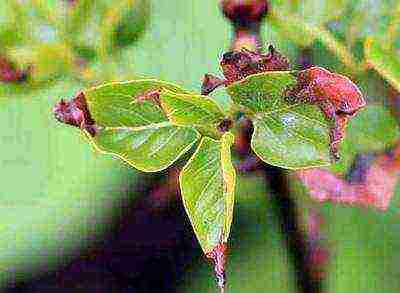
Bacterial rot damages the foliage, flowers, stems and buds of the plant. In some cases, wet spots appear on the surface of the root, which grow very quickly. As the disease progresses, the foliage loses its turgor and dries up, however, its fall does not occur immediately, drying and bending of the stems is also observed. In order to cure lilacs, it is necessary to carry out 3 or 4 sprays with copper oxychloride, while the interval between procedures should be 1.5 weeks.
Powdery mildew
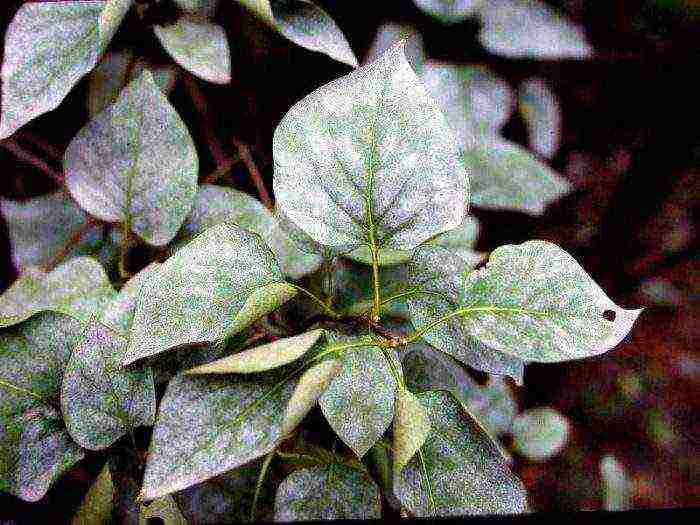
Powdery mildew is a fungal disease that can harm both young and old shrubs.A loose whitish-gray bloom appears on the surface of the foliage, over time it thickens and becomes brown. The progression of this disease is observed in hot dry summers. It is necessary to start treatment of the plant as soon as the first signs of the disease were noticed. The first step is to cut out and destroy all areas affected by the disease, then spray the bush with a fungicide. At the very beginning of the spring period, you should dig up the soil with bleach (per 1 square meter 100 grams), while trying not to injure the root system of the bush.
Verticillary wilting

If you notice that the lilac foliage folds, brown or rusty specks appear on its surface, and they gradually dry out and die off, then this is a sign of another fungal disease - verticillary wilting. The bush begins to dry out from the top, while the disease spreads extremely quickly. The affected bush should be treated with a solution consisting of 1.5 buckets of water, 100 grams of soda ash and the same amount of laundry soap. Spraying the bush with Abiga-Peak also shows good results. Cut out all infected areas and destroy them along with the loose leaves.
Lilac hawk
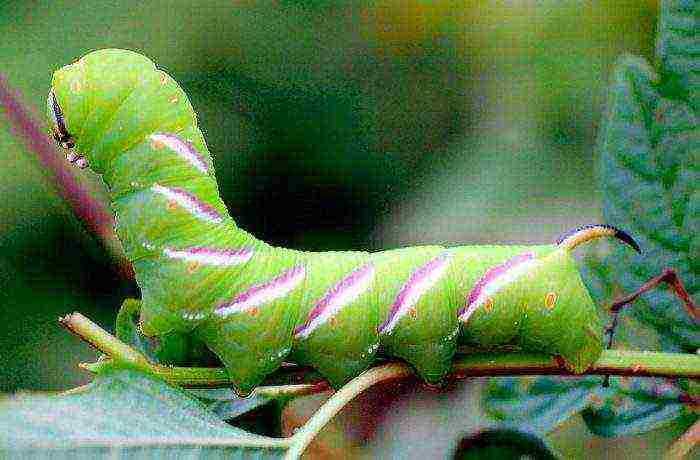
The lilac hawk moth is a large butterfly with a marble pattern on its front wings; it prefers a nocturnal lifestyle. In the caterpillar stage, this pest reaches 11 centimeters in length. It can be distinguished from other pests by its dense horn-like outgrowth located in the back of the body. The moth caterpillar settles not only on lilacs, but also on meadowsweet, currants, viburnum, ash and grapes. To get rid of such a pest, you will need to treat the shrub with Phthalofos solution (1%).
Lilac moth
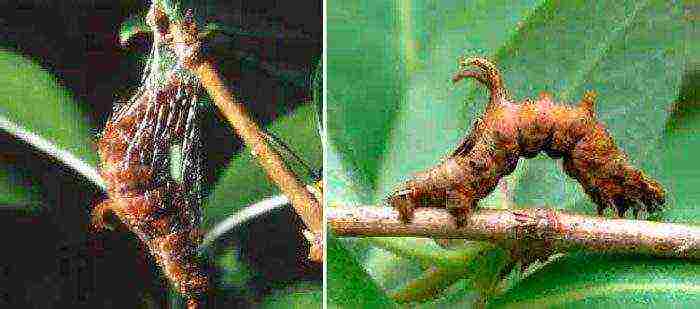
The lilac moth prefers to live on hedges and light forests. In one season, such a pest is able to give 2 generations. Its small caterpillars eat flowers, buds and buds completely, and only veins rolled into a tube remain from the leaf plates. The affected shrub should be sprayed with Fozalon or Karbofos.
Lilac leaf mite
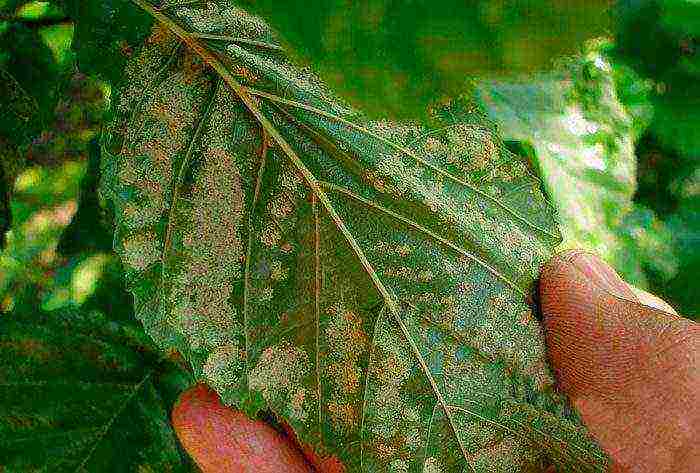
The lilac leaf mite is a very small insect that feeds on lilac plant sap while sucking it off the underside of the foliage. The leaves gradually dry up and change their color to brown. For the purpose of prevention, it is necessary to spray the lilac on the foliage with a solution of iron or copper sulfate, and also systematically thin the crown and feed the plant with phosphorus-potassium fertilizer. Do not forget to collect and destroy fallen leaves in autumn.
Lilac kidney mite

The lilac bud mite spends its entire life in the buds of the plant. He sucks the juice out of them, and also survives in the kidneys and winter. As a result, the buds are deformed, the stems and foliage growing from them are underdeveloped and weak, there is no flowering and over time the plant may die. For prevention purposes, at the very beginning of the spring period (after the frosts are left behind), it is necessary to remove all the fallen leaves and cut off the root shoots, then dig up the soil in the near-trunk circle with a full bayonet with turning the soil, and then the shrub is treated with a solution of copper sulfate.
Miner moth
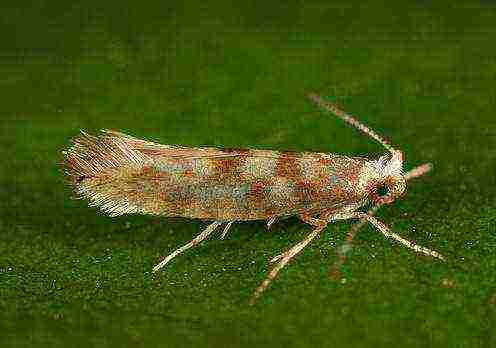
The miner moth can harm the lilac foliage. Initially, a lot of brown dark specks (mines) appear on its surface, and after a while the plates roll up into a tube as if from fire. Infected plants do not bloom, and after 1 or 2 years they die. To get rid of such a moth, it is necessary to abundantly spray the foliage with a solution of Bactofit or Fitosporin-M, or you can use Bordeaux liquid.For preventive purposes, in the autumn, it is mandatory to collect and destroy plant residues, while before frosts and at the very beginning of the spring period, it is necessary to deeply dig the soil in the near-trunk circle.
Reproduction of lilac
Such a plant is propagated by seeds only by specialists in nurseries. For the propagation of varietal lilacs, gardeners use such vegetative methods as: layering, grafting and grafting. If desired, you can purchase grafted or self-rooted seedlings that were obtained from cuttings or cuttings. The advantages of self-rooted lilacs over grafted ones are that it is less demanding, it recovers relatively quickly after wintering, it can be easily propagated by vegetative methods. Own-rooted lilacs are more durable.
Reproduction of lilacs by grafting
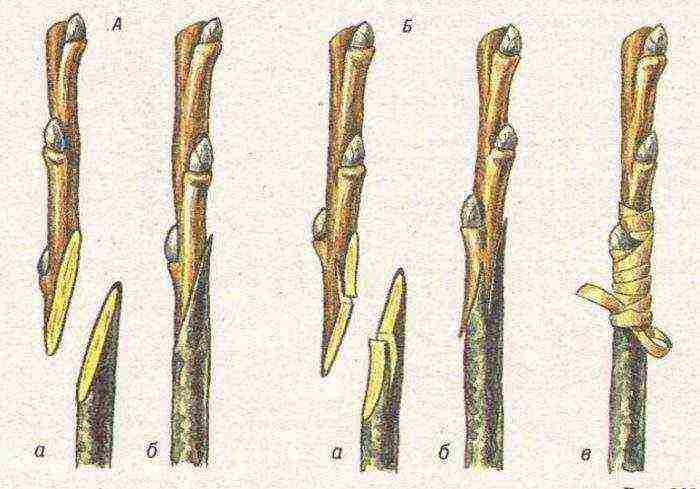
For varietal lilacs, the following rootstocks are used: Hungarian lilac, common lilac and common privet. A dormant bud can be occulated in the summer, and an awakening bud is used for this in the spring. At the same time, it is recommended to vaccinate in the spring, since at this time more than 80 percent of the cuttings take root. In order to make the spring grafting, cuttings are harvested in February or March, then they are wrapped in a paper sheet and placed on a refrigerator shelf (temperature 0-4 degrees). For harvesting cuttings, ripe annual shoots covered with brown bark are used.
Stock preparation should also be done in advance. To do this, you need to cut the side stems to a height of 15 to 20 centimeters and cut out all the root growth. At the rootstock, the root collar should not be thinner than a pencil, while the bark should be well separated from the wood; for this, the plant must be provided with systematic abundant watering 7 days before grafting. On the day of vaccination, to begin with, all the soil is removed from the root collar of the stock. Next, a clean, moistened cloth is taken to wipe the vaccination site. Split the rootstock stump in the center to a depth of 30 mm using the budding knife. At the scion cuttings, the lower end must be cleaned on both sides to a height of 30 mm, as a result, a wedge should be obtained. It is necessary to insert a scion wedge into the rootstock split so that the barked area is completely immersed in the split. After that, the vaccination site must be wrapped with tape, while its sticky surface should look outward. Next, the damage is processed and the places from which the buds were cut off; for this, a garden pitch is used. Then, a plastic bag should be put on the grafted stalk, and it must be fixed just below the grafting site, this will help create a greenhouse effect. The package must be removed only after the swelling of the kidneys is noticed on the scion.
For this procedure, choose a dry sunny day. You need to vaccinate from 16 to 20 pm or from 5 to 10 am.
Lilac propagation by layering

In the springtime, you need to find a young stem that has begun to lignify. It should be pulled with copper wire at the base and in one more place, stepping back from the first 0.8 m, while trying not to injure the bark. Then the shoot is placed in a previously prepared groove, the depth of which is from 15 to 20 mm. It is fixed in this position with pins, so that only the upper part remains on the surface. After some time, young stems will begin to grow from the layer upward, after their height is 15-17 centimeters, these shoots must be covered with nutritious soil, while they are covered with earth at least half the height. In the summer, ensure the layering of systematic watering and weeding, and 1 or 2 more times during the season, add soil under the stems that have begun to grow. After it gets colder on the street, you should cut off the layering at the constriction points.It will need to be cut in such a way that on each of the parts there is a shoot with roots. Such a plot can be planted on a school garden bed for growing, and if desired, it is planted in open soil in a permanent place. Young bushes planted in open ground need shelter for the winter.
Propagation of lilac by cuttings
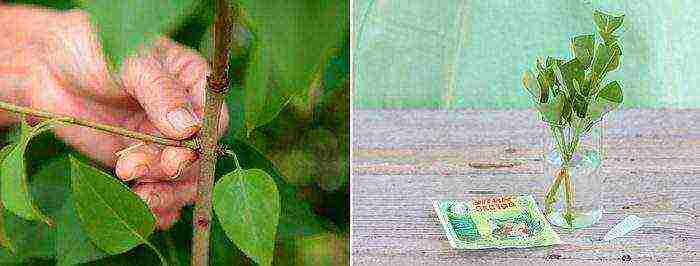
Cuttings of this shrub are quite difficult to root, and in order for this procedure to end successfully, 2 important rules must be taken into account:
- Cutting should be started as soon as the plant has faded, or do it during flowering.
- Cuttings are cut in the morning from young bushes. For this, non-lignified stems are suitable, located inside the crown, which have an average thickness, short internodes and from 2 to 3 nodes.
The cut at the top is made at a right angle, and at the bottom - obliquely. The leaf plates located at the bottom of the cutting must be cut off, and at the top - shortened by ½ part. Next, an oblique cut of the cuttings is immersed in a solution of an agent that stimulates root growth. There he must stay for at least 16 hours.
For the cuttings to take root well, prepare a cutting box or greenhouse. For rooting, it is recommended to use a substrate consisting of peat and sand (1: 1). If desired, the sand is partially replaced by perlite. The container first needs to be sterilized, then a layer of soil twenty centimeters thick is poured into it, which must first be treated with Maxim or Fundazol. On top of this soil, a five-centimeter thick layer should be placed, consisting of calcined river sand. To begin with, the tips of the cuttings should be rinsed using clean water to remove the remnants of the root former. Then the cuttings are buried in a layer of sand and keep such a distance between them so that the foliage of one plant does not touch the leaves of the neighboring one. The planted cuttings must be moistened with a spray bottle, and then covered with a transparent lid. In the event that a regular box or container is used for cuttings, then to cover the cuttings, take a 5 liter plastic bottle and cut off the neck of it. Turn the container over and cover the handle with it. Cuttings for rooting are removed in partial shade. Please note that the sand in the container must not dry out. Systematically humidify the air under the coating using a spray bottle, since the percentage of air humidity there should be 100. To prevent fungal diseases, the cuttings should be sprayed with a weak solution of potassium manganese once every 7 days.
The rooting of cuttings can take from 40 to 60 days. Then they will need to be ventilated every day in the evening, after some time the shelter must be removed for good. When roots appear in the summer, the cuttings will need to be planted in a well-lit area, while the soil should be slightly acidic and light. For wintering, they need to be covered with spruce branches. In the event that the appearance of roots occurred at the end of summer or in autumn, then the plants are left for wintering in the place of rooting, they can be planted in a permanent place only in spring. Shrubs grown from cuttings begin to bloom in the 5th year.
Reproduction of lilac seeds

If you have a great desire to grow lilacs from seeds, then of course you can try. Seeds are collected in autumn in rainy weather. The collected boxes should be dried at room temperature for several days. The recovered seeds should be stratified. The seeds are combined with moistened sand (1: 3), the mixture is poured into a container or bag and put into the refrigerator on a vegetable shelf. She must stay there for 8 weeks. It should be borne in mind that the sand should be constantly slightly damp.
Seeds are sown in the second decade of March and buried in the ground by 1.5 cm. For sowing, garden soil is used, which must be fried or steamed.The surface of the substrate must be moistened with a spray bottle. The first seedlings may appear in 2-12 weeks. After half a month from the moment the seedlings appear, they must be planted, keeping a distance between the plants of 40 mm. After the weather is warm outside, the seedlings can be transplanted into the open ground.
Sowing seeds can be done before winter in slightly frozen soil. In this case, it is not necessary to preliminarily subject the seeds to stratification. In spring, seedlings will appear, which must be dived and sent for growing.
Lilac after flowering
Adult lilacs are highly winter-hardy and do not need shelter for the winter. However, the near-stem circle in young plants must be insulated with fallen leaves and peat, while the layer thickness should be 10 centimeters. It happens that in winter, varietal lilacs are damaged by frost, in this regard, in the spring it will be necessary to prune the stems damaged in winter.
Types and varieties of lilacs with photos and names
There are about 30 types of lilacs, most of which can be found in gardens and parks. Below will be a description of the most popular species and varieties of such a shrub.
Amur lilac (Syringa amurensis)
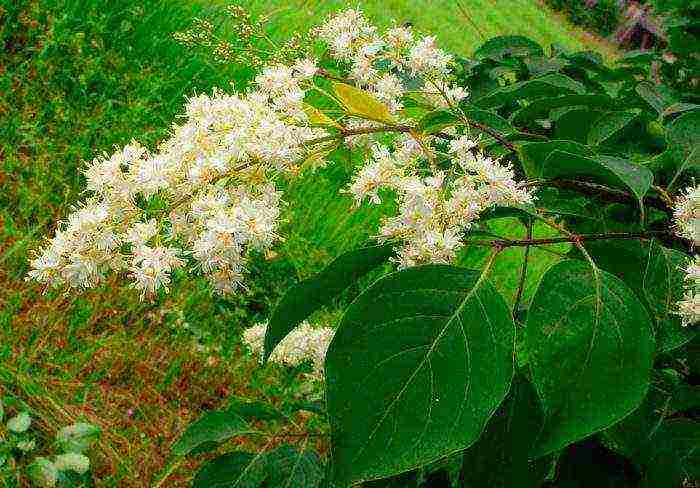
This shade-loving hygrophyte is found in the deciduous forests of the Far East and northeastern China. This species needs a well-moistened soil. It is represented by a multi-stemmed tree, which has a lush spreading crown. Plant height is about 20 meters. This species is cultivated as a shrub, the height of which does not exceed 10 meters. The shape of the foliage of this plant is similar to the leaf plates of common lilac. When the leaves are just opening, they are purple-green in color, in the summer their front surface is dark green, and the back is paler. In autumn, the color of the foliage changes to yellow-orange or purple. The length of the strong panicle inflorescences is about 25 centimeters, they consist of small white or cream flowers with a honey smell. Such a plant is frost-resistant and does not need shelter for the winter. It is grown both solo and in group plantings, and this shrub is also suitable for creating a hedge. Cultivated since 1855
Hungarian lilac (Syringa josikaea)

The homeland of this species is Hungary, the Carpathians and the countries of the former Yugoslavia. The height of the shrub is about 7 meters. Branched dense stems directed upwards. Glossy dark green leaf plates of wide elliptical shape reach a length of 12 centimeters and have a ciliated edge. The lower surface of the leaf plates is greenish-gray, sometimes there is pubescence on the central vein. Rare narrow panicle inflorescences are divided into tiers. They consist of small flowers of lilac color with a mild odor. Such a plant is unpretentious, resistant to urban conditions, it is widely used to create group and single plantings. Cultivated since 1830. Popular garden forms:
- Pale... The color of the flowers is light purple.
- Red... The inflorescences are purple-red.
Meyer's lilac (Syringa meyeri)

The compact plant reaches a height of only 150 cm. The length of small leaf plates is from 20 to 40 mm, their shape is elliptical, tapering towards the top, and have a ciliated edge. The front surface of the foliage is naked, dark green, and the back is paler and has pubescence along the veins. The length of erect inflorescences is 3-10 centimeters, they consist of fragrant pale flowers of pink-lilac color. The species is frost-resistant.
Persian lilac (Syringa x persica)
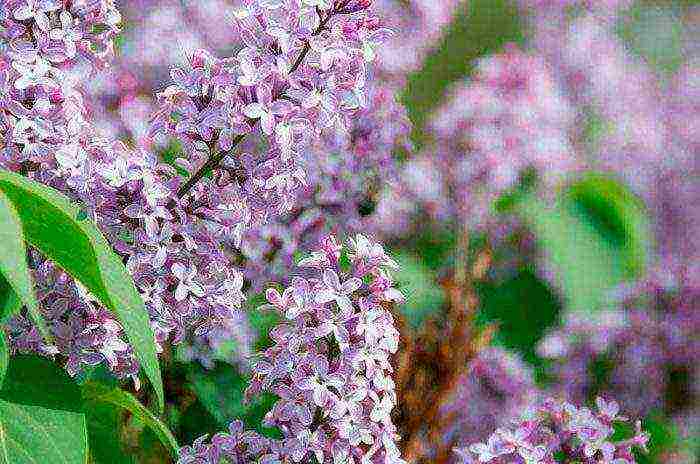
This hybrid was obtained by crossing finely cut lilacs and Afghani lilacs. The height of the shrub is about 3 meters. The length of dense thin leaves is about 7.5 centimeters, they are pointed, lanceolate. Wide, loose panicle-shaped inflorescences consist of fragrant lavender flowers, the diameter of which is 20 mm. Cultivated since 1640.Popular forms:
- White lilac. The color of the flowers is white.
- Red lilac with red flowers.
- Dissected. This dwarf Persian lilac has spreading branches and small pinnately-lobed openwork leaf plates.
Chinese lilac (Syringa x chinensis)

This hybrid was obtained by crossing Persian lilac and common lilac. This species was obtained in France in 1777. The height of the bush is about 5 meters. The length of the ovate-lanceolate pointed leaf plates is about 10 centimeters. The length of the broad-pyramidal drooping panicle inflorescences is about 10 centimeters, they consist of very fragrant flowers, the diameter of which is 1.8 cm.The flowers in the buds are painted in a deep purple color, and when blooming they are purple-red. Popular forms:
- Double. The color of the double flowers is purple.
- Pale purple.
- Dark purple. This form is the most effective of all those related to Chinese lilac.
Lilac hyacinth (Syringa x hyacinthiflora)

This hybrid is the result of the work of V. Lemoine. It is created using common lilac and broadleaf lilac. The leaf plates have a sharp apex and are broadly ovate or heart-shaped. In autumn, their dark green color changes to purple-brown. The flowers are similar to those of common lilac, but the inflorescences are less dense and smaller. It has been cultivated since 1899. The terry form has the greatest effect, there are several more popular forms:

- Esther Staley... The color of the buds is red-purple, and the fragrant flowers are rich red-purple. The diameter of the flowers is about 20 mm, their petals are bent back. The length of the inflorescences is about 16 centimeters.
- Churchill... The color of the buds is violet-red, and the blossoming fragrant flowers are lilac-silver with a pinkish tint.
- Puple Glory... Dense inflorescences consist of large (diameter 35 mm) simple purple flowers.
Common lilac has been cultivated since 1583, it has a large number of varieties created by both domestic and foreign breeders. For example:

- Red Moscow... The color of the buds is purple-violet, and the fragrant flowers are dark purple. They reach 20 mm in diameter and have yellow stamens.
- Violetta... It has been cultivated since 1916. The buds are dark purple, and the double and semi-double large (diameter about 30 mm) flowers are pale purple. They have a low odor.
- Primrose... The buds are yellow-green and the flowers are pale yellow.
- Belicent... The shrub is straight and tall. The length of fragrant openwork pink-coral inflorescences is about 0.3 m. The shape of large slightly corrugated leaf plates is oval.
In addition to these varieties, garden lilacs are popular with such as: Belle de Nancy, Monique Lemoine, Amethyst, Amy Schott, Vesuvius, Vestalka, Galina Ulanova, Jeanne d'Arc, Cavour, Soviet Arctic, Defenders of Brest, Captain Balte, Katerina Havemeyer, Congo, Leonid Leonov, Madame Charles Suchet, Madame Casimir Perrier, Dream, Miss Ellen Wilmott, Montaigne, Hope, Donbass Lights, Memory of Kolesnikov, Sensation, Charles Joly, Celia, etc.
Gardeners also grow the following species: Peking lilac, drooping, Japanese, Preston, Juliana, Komarova, Yunnan, fine-haired, shaggy, Zvegintsev, Nansen, Henry, Wolf and velvety.

Garden lilac always pleases with its delicate aroma, so be sure to plant a bush in your area. It is not capricious, it grows quickly and blooms actively the next year. Our article highlights the basic rules for planting and caring for this plant, and useful tips will help you easily grow a beautiful lilac on your site.
How and when to plant
The optimal time for purchasing lilac seedlings is early autumn. It is then that the rhizomes will take root well in a new place, and the overwintered plant will actively bud in the spring.
The selected specimen should be with green leaves, because dried or yellowed ahead of time, they indicate problems and diseases of the root system.
Summer planting of lilacs is possible if the seedling was purchased in a container. In this case, you should not wait for the first buds until next year, but a plant that has taken root in a new place will willingly grow and develop. 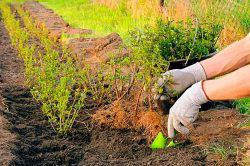
What is needed for landing:
- Enough roomy hole. On poor soils, it must be made about 90 × 90 centimeters, taking into account top dressing and introduced peat.
- Non-acidic and non-clay soil. If the acidity of the soil is below 5.5 Ph, it must be corrected. For this, wood ash, lime and eggshells are used.
- Well-lit landing site. It is advisable to choose the southern and southeastern parts of the site.
- A slight elevation so that moisture does not accumulate. On swampy soils, lilacs can also be grown, but subject to good drainage.
- Adding fertile soil, humus and peat to the hole will accelerate the growth of the seedling. There will be enough feeding for the first year, so a further portion is added in the next season.
- After planting, the roots are well trampled and then watered abundantly. For one seedling, you must use at least 10 - 15 liters of water. The volume will depend on the density of the soil, as well as the hole dug. It will also be interesting to know how cleoma is planted from seeds.
Lilac tolerates partial shade well, but sufficient illumination is an indispensable attribute of successful growth. The plant is also undemanding to the composition of the soil, it can grow well even on poor land, but its acidity is of great importance. If the soil does not meet these requirements, additional liming is necessary, otherwise the plant will die. To illuminate the plant, you can use outdoor lighting at home.
The video shows how to plant and care for lilacs:
The lilac winter shelter is best organized from mulch. Pour at least a bucket of crushed mixture onto the roots, then cover it with boards or sticks. After that, watering is undesirable so that rot does not form on the roots.
How to care
There are a lot of varieties of lilacs, literally every year new varieties, grafted by breeders, go on sale. At the same time, caring for this shrub is simple and it does not matter what kind of lilac is in question.
An important point: pruning the bush. If desired, a neat tree can be formed from any variety. For this, pruning is performed in early spring and after flowering. Lilac tolerates this procedure well, it is believed that cut branches for next year will give more lush and bright flowering.
At the same time, there are some peculiarities. If lilac is preferable in the form of a shrub, pruning of lateral shoots is carried out with a minimum amount to allow several trunks of the plant to develop at once.
To form a stamped tree, about the third year of growth, the lilac is cut at a height of 100 - 120 centimeters so that it looks neater. In this case, it is imperative to trim and cut the lateral shoots, avoiding strong growth of branches.
You may also be interested in learning about what a hawthorn hedge looks like.
Basic rules for growing:
- Obligatory loosening of the soil... On too heavy and wet soils, lilac does not grow well, it can throw off leaves and wither. Loosening is carried out relatively shallow so as not to damage the roots.
- Moderate watering... The lilac root system is well developed, so a lack of moisture will not be a significant threat. Active watering goes before the lilac begins to bloom, after which it is reduced to weekly. For this you can use the gardena automatic irrigation system.
- Young bushes are not fed until the first inflorescences appear. Until that time, the fertilizer applied during planting will be enough for them.
- The flowering plant is fed once a year to keep the flowers brighter and bigger.
- Watering and feeding the plant is not carried out after flowering, so as not to stimulate the growth of shoots before wintering. Usually the deadline is early August.
- Carefully it is necessary to feed the lilac with nitrogen fertilizers.... They stimulate the formation of shoots and leaves, but can completely stop flowering.
- The inclusion of phosphorus in the "diet" as a top dressing will help the formation of beautiful and lush inflorescences. Consumption is calculated from the norm of 40-60 grams per bush, depending on its size.
- You can use wood ash, which alkalizes the soil.... It is necessary to make at least two tablespoons for each bush, mixing it with water.
- Lilac propagates by cuttings that can be dug from the parent bush... After the seedling takes root, the connection is broken, and the sprout can be dug up and transplanted. But how the cuttings of Chrysanthemums are planted, this article will help to understand.
- In order for only large inflorescences to form on the branches, it is necessary to remove up to 25% of flower buds at the stage of their formation.
- Cutting lilac flowers is best in the morning or late evening. It is imperative to use a pruner for this, so as not to injure the branches.
It will also be interesting to learn more about how the forsythia shrub looks in the photo, as well as how it needs to be planted.
The video shows the cultivation of lilacs:
On the site, lilacs can be used as a hedge. For this, undersized varieties are planted, which are easier to cut and shape. Saplings must be planted at a distance of no more than one meter from each other along the perimeter of the future fence. Around the second year of growth, the branches must be braided together and fastened with soft wire or twine.
For a decorative effect, the resulting hedge is sheared after flowering, and if this is not planned - in early spring.
Blooming lilacs are an unusually beautiful decoration for your site. Delicate inflorescences give an indescribable aroma, and cheerful foliage will delight the eye until late autumn. It is impossible to describe the types of lilacs, and the unpretentiousness of this shrub has long become a good "springboard" for beginners in gardening. The basic rules for the successful planting and growing of this plant are described in detail in the information of our article.
Lilac is one of the most beloved shrubs, the flowering of which is associated with the real onset of spring. The divine aromas spreading during this period fascinate, make you fall in love. Due to its dense lush crown, the plant is often used to form green walls that cover a certain territory from prying eyes.
Belonging to the olive family, lilacs are one of the main inhabitants of gardens and household plots. Outwardly, this luxurious shrub is characterized by large purple, pink or white flowers, collected in paniculate inflorescences, located at the ends of the branches. The fruit is a bivalve dry capsule. Leaves are green, most often whole, less often pinnately-divided; fall for the winter. Lilac, planting and caring for which in the household is practically minimized, is distinguished by its high endurance, grows well in the open air.
The most popular types of lilacs
According to the varieties, lilacs, planting and caring for which are quite easy, are divided into simple and terry. The most widespread is the common lilac, a native of the Balkan Peninsula, on the territory of which it grows at a high altitude and clings to its roots on steep rocky slopes. It blooms in May with purple and white flowers. Counts a plurality of varieties.
Persian lilac. It is characterized by fragrant purple flowers. Some of its varieties have pinnate-cut leaves. The flowers are white.
Chinese lilac. It is a hybrid of common and Persian.It is characterized by large red-purple flowers.
Hungarian lilac. The flowers are purple, with a subtle scent. Flowering occurs in late May - June.
Lilac: planting and care in the open field
It is recommended to plant lilacs on neutral or slightly alkaline soils; too waterlogged soil can cause the death of the plant.
The landing site should be well lit; with a lack of sun, plant growth will be slow, flowering may be absent. Strong sunshine can cause the appearance of small and rapidly flowering inflorescences in lilacs. The best place for planting is a sunny, well-protected place from the winds.
Planting lilacs should be carried out in late summer - early autumn, preferably in the evening or damp, cloudy weather. The depth of the planting hole, dug in advance in 2-3 weeks, is recommended from 0.5 to 1 meter with the same width. Be sure to add organic fertilizers, wood ash or humus when planting in the soil (up to 20 kg per planting pit).
High-quality flowering will be observed with normal growth, which depends on how well the lilac is maintained. Planting and care (the photo shows all the beauty of your favorite plant), if carried out correctly, combined with love for the plant, will determine its continuous gorgeous flowering and active growth.
Every autumn, the soil needs to be dug to a depth of about 12 cm, carefully so as not to damage the roots of the plant. For the winter, the dug soil should be left unleveled so that the weed seeds in it will freeze over the winter.
Top dressing of lilacs is done in early spring, as soon as the shoots begin to grow back. A mineral complex is introduced under one bush, consisting of 20-30 grams of ammonium nitrate, 30 grams of superphosphate, 15-20 grams of potassium chloride; the seeding depth is 10-15 cm. It is recommended to fertilize with mineral fertilizers simultaneously with the introduction of mullein or slurry.
The second feeding is carried out during the period of bud formation with the same composition.
How to properly prune lilacs
Planting and caring for, pruning are important factors contributing to the quality growth of this crop. The purpose of pruning is to form the crown and maintain the shape of the bush, which leads to abundant annual flowering.
In the first two years from the moment of planting, the growth of lilacs is rather weak, therefore the nature of the pruning is sanitary and thinning. In the third year, when the growth of the bush is activated, a radical pruning is required. In early spring, it is necessary to select about 10 strong shoots in the crown, giving the shrub a spreading shape and as distant as possible from each other. Subsequently, it is these branches that will become trunks; the rest of the shoots should be cut off. The small branches directed inward to the crown should be cut completely, the stronger ones directed outward should be shortened. If the lilac is cut in the fall, it will not bloom next spring. Also, around the lilac bush, it is required to regularly remove root shoots and rhizome offspring.
Reproduction of lilac
Reproduction of lilacs is carried out by root shoots, cuttings and grafting, used mainly for garden forms. For cuttings, it is required to take well-leafy, semi-lignified shoots; in this case, the leaf blades must be reduced by half. Make the lower cut oblique, under the internode, the upper one above the leaf node. For rooting, the cuttings must be planted in coarse sand, poured onto the nutrient soil of the greenhouse with a 3-5-centimeter layer. After planting and spraying the planted branches with water, the greenhouses should be covered with frames, providing the plants with diffused light and a temperature of + 25-30 degrees. As they take root, the cuttings are gradually accustomed to open air. Cuttings rooted in greenhouses are left for the winter, having previously covered them with foliage or spruce branches.They can also be stored buried in the basement in winter. In the spring, land on the beds.
How to keep cut lilac fresh: tips
How to keep freshly cut lilacs in a vase for a long time, planting and caring for which at the exit resulted in a chic, beautifully formed bouquet? To do this, you need to know a few subtleties of such a delicate operation.
You need to cut it in the early morning, while removing most of the leaves from the branches, because they evaporate a lot of moisture. Cut lilacs last longer from young bushes than from old ones. The inflorescence should have at least 2/3 of the opened flowers, because the buds will not bloom in the cut. Before placing a bouquet in a vase, you need to refresh the oblique sections by making new ones under water. A tricky but effective technique: crush the ends of the shoots with a hammer. It is recommended to add 2-3 grams of acetic or citric acid to the water. A withered bouquet can be freshened up by placing it in very hot water.
Plant diseases and pests
For those who want to acquire a chic, pleasantly smelling plant on their own plot, it is worth knowing everything about this culture: what are behind such a plant as lilac, planting and care, its diseases, pruning timing and watering regime. Pests and diseases rarely affect lilacs. This is a lilac miner moth, the object of which is the leaves of a bush. After exposure to this insect, the lilac looks as if burnt and practically does not bloom the next year. Fight against such a pest should be by deep digging of the soil under the bush in autumn and spring (in order to destroy the pupae that have settled in the soil), cutting and burning the affected shoots.
Also, lilacs, planting and caring for which bring a lot of joy to true lovers of beauty, is sometimes struck by bacterial necrosis; this happens in early August. The disease is transmitted by irrigation water, insects, planting material. It is possible to determine the presence of this disease by the graying of the leaves and the browning of the shoots. In this case, the use of drugs aimed at pest control, removal and disposal of damaged plant parts, uprooting and burning of heavily affected bushes is required.


